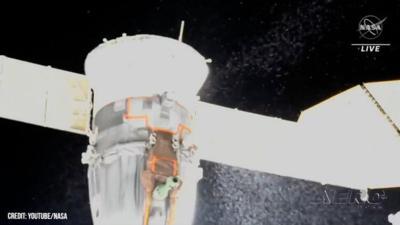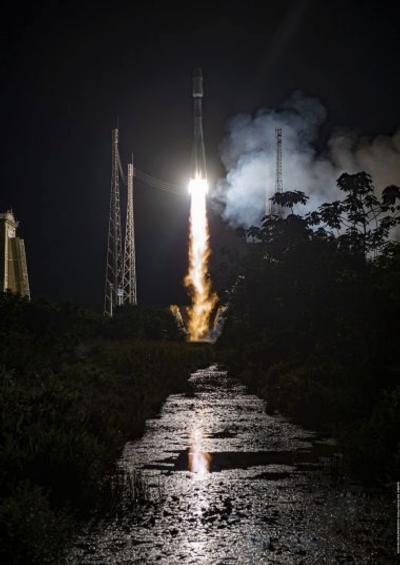Fri, Jan 13, 2023
Meteoroid Strike Damages Spacecraft, Ending Reentry Plans
Russia's space agency plans to launch a replacement Soyuz capsule to the International Space Station next month, replacing the damaged module in orbit.

The move comes after a micrometeoroid strike that perforated a portion of the MS-22 spacecraft, leading to a visible coolant leak from the outside. The capsule could no longer regulate interior temperatures, projected to creep north of 100º during reentry. With such damage, a trip back to Earth aboard the Soyuz is impossible, stranding the personnel in orbit. A new MS-23 Soyuz will be launched on February 20 from the Baikonur Cosmodrome in Kazakhstan. Luckily for the team, the replacement was already slated for launch next March, so advancing the schedule by a month is a relatively minor change of plans.

The new spacecraft will offer NASA and Roscosmos astronauts both a safe capsule and a ride home for those who could conceivably have been left stranded on the station in the event of an emergency. Since the December 14th coolant leak, the astronauts on the station have only had the SpaceX Dragon as a lifeboat - meaning only 5 of the 7 on the station could count on a safe return to earth. The new capsule will likely be used to return astronauts Frank Rubio, Sergey Prokopyev, and Dmitry Petelin, but staff says that there's a good amount of wiggle room as to when such a voyage would occur.
Rubio & co. will most likely wait a few extra months, since MS-23's fresh replacement crew will not be accompanying their Soyuz to the station. They'll now wait for MS-24 to be completed. Their original 6-month mission began in September of 2022, meaning that they could well be up in space for a year before their relief crew is ready for launch. NASA is weighing delays to its own Crew-6 launch in mid-February to possibly help Roscosmos balance out their launch schedules for greater efficiency.
Of interest is that MS-23 will have to use MS-22 as a donor 'car' of sorts. The cosmonauts will take their custom seat liners, Sokol entry suits, and gear to their new ride home before sending it back to Earth uncrewed.
More News
Outboard Section Of The Right Wing And The Right Flap Separated In Flight And The Airplane Impacted A Farm Field Analysis: The pilot was approaching his destination airport under i>[...]
Final Approach Fix The fix from which the final approach (IFR) to an airport is executed and which identifies the beginning of the final approach segment. It is designated on Gover>[...]
"Our choice of when to respond, how to respond and on which targets to respond is a consideration that we make every time... Netanyahu also noted that anyone attacking Israel &ldqu>[...]
Estimated (EST) When used in NOTAMs “EST” is a contraction that is used by the issuing authority only when the condition is expected to return to service prior to the e>[...]
Aero Linx: Coalition of Airline Pilots Associations (CAPA) The Coalition of Airline Pilots Associations (CAPA) is the world’s largest pilot trade association representing ove>[...]
 NTSB Final Report: Cessna 177B
NTSB Final Report: Cessna 177B ANN's Daily Aero-Term (05.08.25): Final Approach Fix
ANN's Daily Aero-Term (05.08.25): Final Approach Fix Aero-News: Quote of the Day (05.08.25)
Aero-News: Quote of the Day (05.08.25) ANN's Daily Aero-Term (05.09.25): Estimated (EST)
ANN's Daily Aero-Term (05.09.25): Estimated (EST) ANN's Daily Aero-Linx (05.09.25)
ANN's Daily Aero-Linx (05.09.25)




